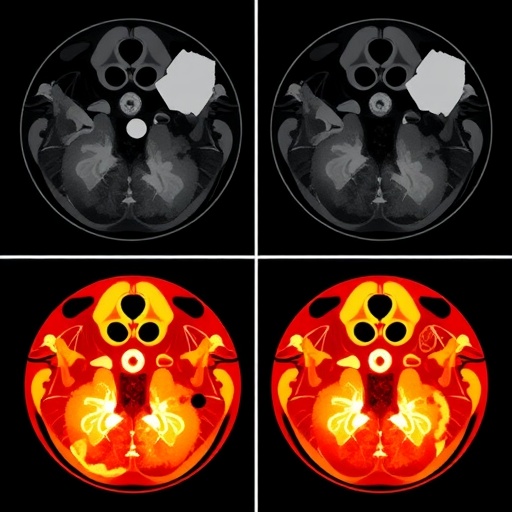In groundbreaking research poised to reshape postoperative evaluation in chronic rhinosinusitis (CRS), an international team of biomedical engineers and clinicians has unveiled a cutting-edge analytical framework harnessing the power of artificial intelligence and transfer learning. Chronic rhinosinusitis, characterized by persistent inflammation of the sinuses, demands precise postoperative assessment to optimize patient outcomes and tailor subsequent treatments. However, conventional methods rely heavily on subjective interpretation of endoscopic images, often leading to variability and inconsistent diagnostics.
To address this critical challenge, researchers have developed an innovative model employing pre-trained foundation algorithms capable of extracting nuanced features from postoperative endoscopic images of the sinonasal cavity. This model leverages the advancements in deep learning, specifically transfer learning paradigms, where large-scale neural networks pre-trained on extensive datasets are fine-tuned for specific downstream tasks. The framework stands apart by enabling consistent, objective, and reproducible analysis in a domain historically fraught with interpretative inconsistencies.
A core aspect of the study involved classifying postoperative sinus cavity images into three distinct categories: polyp presence, mucosal edema, and smooth mucosa, each reflecting different states of sinus pathology. The classification task was particularly challenging due to subtle visual variations and the limited availability of annotated medical image datasets. By utilizing transfer learning on pre-trained large models specialized for endoscopic imagery, the researchers surmounted these data constraints and achieved a remarkable diagnostic precision exceeding that of traditional machine learning approaches.
Benchmarking this novel approach against conventional training methods revealed the model’s superior capability, especially notable given the typical scarcity of labeled medical images. One of the standout performance metrics was the model’s accuracy in differentiating smooth mucosa from pathological conditions (polyps and edema), achieving a mean accuracy surpassing 91% and an Area Under the Curve (AUC) nearing 0.97. Such high sensitivity and specificity measures underscore the potential of this technology to elevate clinical decision-making standards.
Equally compelling was the model’s proficiency in distinguishing polyp formations from other mucosal states. Here, it recorded over 81% accuracy with an AUC of 0.90—a substantial 15% improvement compared to existing diagnostic algorithms. This remarkable enhancement suggests that pre-trained foundational models, when fine-tuned via transfer learning, can capture critical visual markers that may elude even seasoned clinicians during conventional endoscopic evaluations.
The research methodology demonstrated not only robust diagnostic outputs but also an inherent ability to generalize well across diverse datasets from multiple clinical centers. This multicenter design bolsters confidence in the model’s applicability in real-world clinical workflows and underscores the adaptability of transfer learning in heterogeneous medical imaging environments. It paves the way for integration into endoscopy suites, enhancing real-time assessment and enabling personalized postoperative management strategies.
At its core, the study confronts a long-standing obstacle in otolaryngology: the high subjectivity embedded in postoperative endoscopic evaluation for CRS. By deploying AI-driven analysis rooted in pre-trained foundation models, the framework standardizes outcome measurements, mitigating human errors and interobserver variability. This is particularly crucial in chronic conditions where subtle mucosal changes can indicate disease recurrence or remission, necessitating timely intervention.
Moreover, the approach’s efficacy with limited datasets addresses a widely acknowledged bottleneck in developing AI models for medical imaging. Unlike traditional algorithms that require vast labeled samples to perform optimally, the transfer learning basis leverages generalized features learned from broader contexts, thereby accelerating convergence and enhancing model robustness with fewer training images. This efficiency holds promise for accelerating AI adoption in various subspecialties of medicine where data scarcity remains a persistent hurdle.
As this technology advances, it could transform postoperative follow-up protocols by enabling objective monitoring and early detection of unfavorable mucosal changes. Patients recovering from sinus surgery might benefit from more personalized care, informed by AI assessments that complement clinical expertise. Furthermore, it lays a foundation for future explorations integrating multimodal data to refine prognostic models and guide therapeutic decision-making dynamically.
The broader implications extend beyond CRS, showcasing how foundation models and transfer learning can revolutionize endoscopic image analysis across multiple anatomical sites. The success of this framework underscores the burgeoning synergy between biomedical engineering and clinical practice, heralding a new era where AI not only assists but augments physician skills in real-time diagnostic settings.
In conclusion, this pioneering work exemplifies how modern artificial intelligence methodologies—particularly transfer learning on pre-trained foundation models—can surmount long-standing hurdles in medical image interpretation. It offers a scalable, reproducible, and highly accurate tool for postoperative evaluation in chronic rhinosinusitis, one that promises to enhance patient outcomes through more consistent and objective diagnostics, all while accommodating the practical limitations of clinical data availability.
Research of this caliber marks a significant leap forward, bridging the gap between emerging computational advances and their tangible clinical applications. As these models continue to evolve, their integration into routine medical workflows could redefine standards of care, fostering a future where technological precision and human expertise converge to deliver superior healthcare outcomes worldwide.
Subject of Research: Postoperative evaluation of chronic rhinosinusitis using AI-driven analysis of endoscopic images through transfer learning on pre-trained foundation models.
Article Title: Postoperative outcome analysis of chronic rhinosinusitis using transfer learning with pre-trained foundation models based on endoscopic images: a multicenter, observational study
Article References: Gong, W., Chen, K., Chen, X. et al. Postoperative outcome analysis of chronic rhinosinusitis using transfer learning with pre-trained foundation models based on endoscopic images: a multicenter, observational study. BioMed Eng OnLine 24, 95 (2025). https://doi.org/10.1186/s12938-025-01428-y
Image Credits: AI Generated
DOI: https://doi.org/10.1186/s12938-025-01428-y




